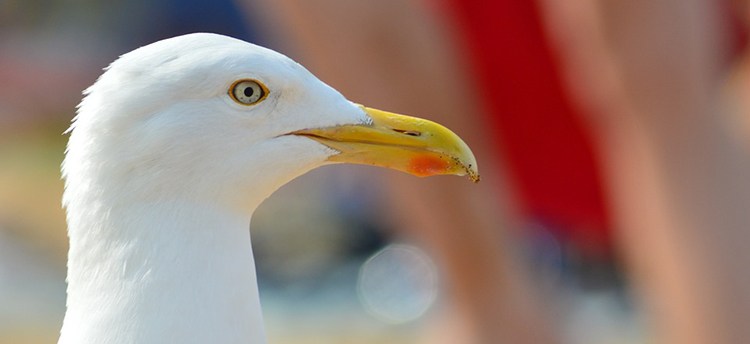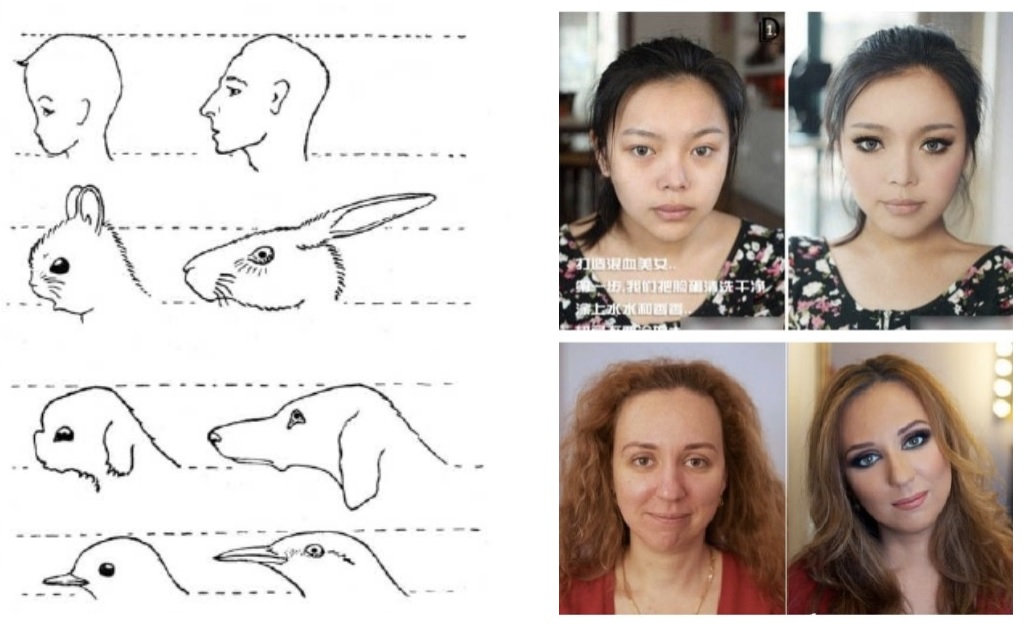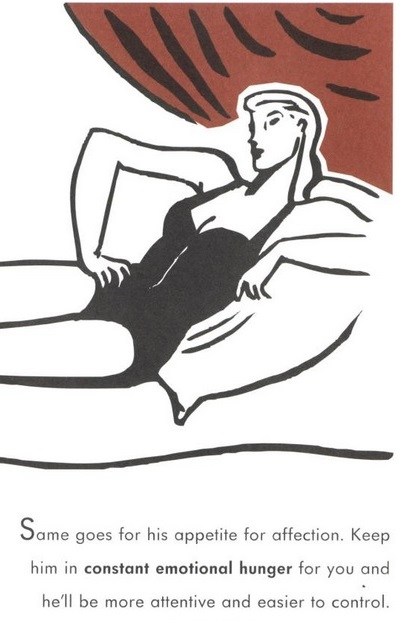By Peter Wright & Paul Elam
Many students of sexual politics posit the “scientific” notion that our culture of extreme gynocentrism is a basic biological reality; that we should either get with the program and enjoy it or bow out in a nihilistic fashion.
An alternative explanation of gynocentrism suggests it is merely an exaggeration of human potential; one that leads to social and reproductive failure despite common beliefs.
The bioscience lexicon can be helpful in understanding this.
A superstimulus refers to the exaggeration of a normal stimulus to which there is an existing biological tendency to respond. An exaggerated response, or, if you will, superresponse, can be elicited by any number of superstimuli.

For example, when it comes to female birds, they will prefer to incubate larger, artificial eggs over their own natural ones.
Large, colorful eggs are a superstimulus. Leaving real eggs out to die is the superresponse.
Similarly, humans are easily exploited by junk food merchandisers. Humans are easily trained to choose products that cause heart disease, diabetes, and cancer over the nutritious food they evolved to eat and thrive on, simply by playing tricks on the taste buds and manipulating the starvation reflex.
Sugar and refined carbohydrates are superstimuli. Consuming toxic substances is the superresponse.
The idea is that healthy human behavior evolved in response to normal stimuli in our ancestor’s natural environment. That includes our reproductive instincts. The same behavioral responses have now been hijacked by the supernormal stimulus.1
From this perspective, we see that a superstimulus acts like a potent drug, one every bit comparable to heroin or cocaine which imitate weaker chemicals like dopamine, oxytocin, and endorphins, all of which occur naturally in our bodies.
As with drug addictions, the effects of superstimuli account for a range of obsessions and failures plaguing modern man – from the epidemic of obesity and obsessions with territoriality to the destructive, violent and suicidal behaviors central to our modern cult of romantic love.
An interesting tidbit about superstimuli of manufactured narcotics is the phenomenon known as “chasing the dragon.” It is a term that originated in the opium dens of China, and it refers to what happens the first time a person inhales opium vapor. The resulting euphoria is complete, even magical — the first time.
Subsequent to that, the user tries again and again, with ever-increasing amounts of the drug, to re-create that first blissful high. They can’t do it. The brain is now familiar with the flood of manufactured opiates. The user gets high and very addicted, but the magic of the first experience is an elusive butterfly.
They pursue it, though, with all their might, chasing the dragon they rode in their first experience.
We see a similar phenomenon with men trying desperately in their relationships with women to be rewarded with redeeming love, sex and approval, through the use of romantic chivalry. It sends them, like an addict, traveling the path of a Mobius strip, going in circles, chasing the dragon.
There is little doubt in our minds how this happens.
Here are three examples of human superstimuli, and how they are used to elicit a destructive superresponse in the human male.
1. Artificially manufactured neoteny
Neoteny is the retention of juvenile characteristics in body, voice or facial features. In humans, neoteny activates what is known as the parental brain, or the state of brain activity that promotes nurturance and caretaking. The activation occurs through something called an innate releasing mechanism.
A classic example of an innate releasing mechanism is when seagull chicks peck at the parent’s beak to get food.
Each adult seagull has a red spot on the underside of their beak, the sight of which instinctively triggers, or releases, the chicks to peck. It is the innate releasing mechanism.

This innate releasing mechanism, of course, is essential to the survival of seagulls, and there is something like it to be found in all birds and mammals — any creature that cares for its offspring. In mammals, juvenility is one of the innate releasing mechanisms that unconsciously determine our motivations to protect and provide, thus ensuring the survival of the species.
Juvenile characteristics in humans, however, can also be manipulated to garner attention and support that far exceeds the demands of survival.
In particular, neoteny is exploited by women to gain various advantages, a fact not lost on medical doctor and author Esther Vilar, who writes:
Woman’s greatest ideal is a life without work or responsibility – yet who leads such a life but a child? A child with appealing eyes, a funny little body with dimples and sweet layers of baby fat and clear, taut skin – that darling minature of an adult. It is a child that woman imitates – its easy laugh, its helplessness, its need for protection. A child must be cared for; it cannot look after itself. And what species does not, by natural instinct, look after its offspring? It must – or the species will die out.
With the aid of skillfully applied cosmetics, designed to preserve that precious baby look; with the aid of helpless exclamations such as ‘Ooh’ and ‘Ah’ to denote astonishment, surprise, and admiration; with inane little bursts of conversation, women have preserved this ‘baby look’ for as long as possible so as to make the world continue to believe in the darling, sweet little girl she once was, and she relies on the protective instinct in man to make him take care of her.” 2
Zoologist Konrad Lorenz discovered that images releasing parental reactions across a wide range of mammalian species were rounded heads and large eyes (left), compared with angular heads with proportionally smaller eyes that do not elicit such responses.

Compare Lorenz’s images on the left with images of skilfully applied eye makeup above by the modern woman in search of romance. The many colored eyeshadows, eyeliners, and mascaras, not to mention the hours practiced in front of the mirror opening those eyes as wide as possible and fluttering – all designed to spur the viewer’s paleo reflexes into action.
Neotenic female faces (large eyes, greater distance between eyes, and small noses) are found to be more attractive to men while less neotenic female faces are considered the least attractive, regardless of the females’ actual age.3 And of these features, large eyes are the most effective of the neonate cues4 – a success formula utilized from Anime to Disney characters in which the eyes of adult women have been supersized and faces rendered childish.
2. Exaggeration of sexual qualities
Clothing and postures which exaggerate the hips, thighs, ass, breasts have been cultivated for millennia.
The cut, color, and drape of clothing; the underwear, corsets, lingerie and the shoes, hats, jewelry and other accessories make for a long study in the evolution of fashion – and in terms of sexuality they stand for nothing less than superstimuli designed to elicit an overload of sexual attraction in the viewer.
Perhaps more interesting on the enhancement front is the arrival of plastic surgery designed to transform the body into a theater of superstimuli, sometimes with grotesque, even fatal results. Such is the risk invited and embraced in the pursuit of enhanced sex-appeal.
Breast implants, butt implants, botox injections, nose jobs, tummy tucks, facelifts – all designed for enhanced sexuality, and even more importantly, enhanced power and control.
3. Artificially intensified pair-bonding drive
We have all heard the advice of the seasoned matron to younger women; “Don’t turn your love on like a tap or he will lose interest – withhold some affection and you’ll always have him begging for more.”
 This message is now so widespread that animal-training techniques are being redeployed by women who wish to control their man’s attachment needs. In How to Make Your Man Behave in 21 Days or Less Using the Secrets of Professional Dog Trainers we read,
This message is now so widespread that animal-training techniques are being redeployed by women who wish to control their man’s attachment needs. In How to Make Your Man Behave in 21 Days or Less Using the Secrets of Professional Dog Trainers we read,
Consistently a dog is “nicest” when he wants to be fed. Then he becomes all wags and licks. A known trick for keeping a dog on his best behavior is to just fill his bowl halfway so he’s yearning for more.
Same goes for his appetite for affection. Keep him in constant emotional hunger for you and he’ll be more attentive and easier to control.
As cruel as it sounds, withholding affection, sex, approval and love have become part of women’s repertoire of superstimuli used to coerce men into service. Perhaps there was a time when that service could have been considered an appropriate response to a survival oriented stimulus. Now, however, it has been replaced by superstimuli and male service has degenerated into a destructive superresponse.
Such dating advice for women abounds on the internet with the aim to intensify a man’s desire by turning a secure bond, a necessity for healthy relationships, into a brass ring. Only on the ride of romantic chivalry, like all carnival sideshows, the game is rigged. The brass ring remains ever just out of reach.
Men’s basic human need for love, acceptance, and security, is frustrated, leaving them in a perpetual cycle of deprivation.
Indeed, it is one of the core principles of romantic love to keep the bond in the realm of tantalizing denial, and men, therefore in constant readiness to be manipulated and used.

The word tantalizing comes from the Greek story of Tantalus. Tantalus, as the fable goes, offended the Gods. His punishment was to be placed in a river with the water up to his neck. A tree full of ripe, red apples leaned toward him.
The Gods afflicted him with a raging thirst and hunger. When he bent his head down to slake his thirst – the waters receded. Likewise, when he reached up to grab one of the apples, the branch recoiled higher and out of his reach.
Women are socialized to tantalize men with the possibility of pair-bonding, to keep fruit of love ever out of reach, and to further muddy the waters with the dictates of romantic chivalry.
If you want that pair-bond, which is to say if you want to be more tantalized, you had better greet her with flowers, hold the door open, and of course pick up the bill.
Be prepared to live that way for the rest of your life, exiled to the river with Tantalus, ever thirsty and hungry. In modern times, simple attachment is transformed into something complex – an impulse now guided by customs of a romantic chivalry, designed to tilt maximum power toward the woman.
Even when the pair-bond is supposedly attained, you may still experience the withdrawal of love, sex and approval as a method of control. It can even be worse once bonded than during the courtship process.
Such behavior from women is not a simple, innate reflex, but one in which they are culturally educated and socialized. Most girls become fluent in the game of inclusion and exclusion, in groups or among friends, well before the reach the age of 10 and the meta-rules learned there reappear again in popular dating advice – rules designed to meddle in the attachment security we social creatures would otherwise enjoy sans the manipulations.
The rules for women resonate shamelessly throughout an entire genre of literature:
– Keep an air of mystery
– Only put in 30 percent effort
– Make him come to you
– Never see him with less than 7 days notice
– Never call him unless returning a call
– Never return a call or text immediately
– Make him approach you
– Don’t call back immediately. You are a girl in demand.
– End call first after 15 minutes ALWAYS. (Even though it sucks. He will call you more.)
– Even if you are not busy, pretend like you are
Those items are the product of a cursory scan of just two internet dating sites with advice for women. They are not, however, an invention of the information age. They are the long codified expressions of what women have been taught, from generation to generation, since the advent of romantic chivalry.
They are obedience training basics for conditioning the romantically chivalrous man — superstimuli, powerfully effective in eliciting a superresponse. In this case, servile, blind sycophancy from weak, non-introspective men.
Romantic Love
Romantic love can be reconceptualized as a cluster of superstimuli, with each facet driving the human nervous system into over-excitement. That excitement tends to negatively impact men’s long-term welfare. The damage is not contained there. Our social and familial world is disintegrating rapidly under the excesses and toxicity of romantic love. In a way, romantic love has become one of the most anti-human exploitations of human biology to ever grace our species.
To understand where this originated we need to take a brief look at the history of romantic love, previously called courtly love, to show that the same elements were already at work at its inception. As laid out in great detail by medieval forebears, the literature reveals the same exaggerated neoteny, enhancements of sexuality, and the same obsessions surrounding control of romantic attachment.
While the neoteny ploy has been in operation at least since ancient Egypt in the form of colored eyeshadow and eyeliners, the practice gained greater popularity after the Crusaders found eyelid-coloring cosmetics used in the Middle East and who spread the practice throughout Europe.5 By the Middle Ages, European aristocrats were widely using cosmetics, with France and Italy becoming the chief centers of cosmetics manufacturing, including the use of stimulant compounds like Belladonna (Italian name meaning “beautiful woman”) that would make the eyes appear larger.6
Thus neoteny, manufactured by artisan techniques, became the cultural inheritance of each successive generation of girls who were – and still are – taught the art of applying and then displaying makeup, especially to the eyes. Such practices probably encouraged praises of women’s eyes in troubadour poetry, such as we read by the poet Ulrich von Liechtenstein in his autobiography titled In The Service of Ladies. There we read;
The pure, sweet lady knows well how to laugh beautifully with her sparkling eyes. Therefore I wear the crown of lofty joys, as her eyes become full of dew from the ground of her pure heart, with her laughing. Immediately I am wounded by Minnie.”

Clothing too was always used to enhance sexuality, however fashions didn’t change much over the course of millennia and their sexual utility was not fully realized. The beginnings of frequent change in clothing styles, along with recognition of their multitude ways of enhancing sexuality, began in Europe at a time that has been reliably dated by fashion historians James Laver and Fernand Braudel to the middle of the 14th century – a period when sexualised items like lingerie and corsets began their rise to fame.7
Jane Burns PhD adds further evidence of clothing’s role of sexually empowering medieval women in her book Courtly Love Undressed: Reading Through Clothes in Medieval French Culture.8
As mentioned earlier, the most powerful of romantic love’s tricks was the tantalizing of men with a promise of attachment, a goal that would remain largely out of reach. Stories of the troubadours attest to a hope-filled agony that plagued the male lover, with men dwelling in a strange kind of purgatory in waiting for a few “solaces” from the beloved.
The medieval love-game went into full swing when codes of romantic conduct encouraged a toying with the two extremes of acceptance and rejection. Compare the above list of dating rules with the following list from The Art of Courtly Love – a love manual widely disseminated in the 12th century:
– Love is a certain inborn suffering.
– Love cannot exist in the individual who cannot be jealous.
– Love constantly waxes and wanes.
– The value of love is commensurate with its difficulty of attainment.
– Apprehension is the constant companion of true love.
– Suspicion of the beloved generates jealousy and therefore intensifies love.
– Eating and sleeping diminish greatly when one is aggravated by love.
– The lover is always in fear that his love may not gain its desire.
– The greater the difficulty in exchanging solaces, and the more the desire for them, and love increases.
– Too many opportunities for seeing each other and talking will decrease love.9
Shakespeare’s most romantic of plays tells the same story, with Juliet keeping her lover midway between coming and going, between stable pair-bonding and the single life. Here Juliet tells her obedient lover;
‘Tis almost morning. I would have thee gone.
And yet no further than a wanton’s bird,
That lets it hop a little from his hand
Like a poor prisoner in his twisted gyves,
And with a silken thread plucks it back again,
So loving-jealous of his liberty.
To which Romeo replies, in accord with the expectations of romantic love;
I would I were thy bird.
Following this little detour into history we now come to a final juncture of this article where we ask Aristotle’s million dollar question – that for the sake of which. To what end are these superstimuli employed?
Many would offer the clichéd answer that such practices garner “reproductive success,” that the woman employing them gains a quality mate and produces offspring to perpetuate the species. But this explanation is too simple. For starters, there are other aims of a human life than reproduction; such as garnering of food resources, securing wealth, attachment needs, or of securing narcissistic gratification for a woman who may never intend to have offspring – the resources garnered via her carefully orchestrated superstimuli can serve other ends.
Moreover, it appears not to have entered the minds of the reproduction enthusiasts that such strategies may, in fact, be deleterious to reproduction – all one has to do is look at the failing relationships everywhere, lowering birth rates, and decaying societies in the West that do not portend a future of success riding on the back of the superstimuli we’ve grown so fond of exploiting.
Narcissistic gratification is certainly one motive we’ve under-emphasized in our focus on reproduction, though it too is not the final motive. There can be nothing more gratifying to the narcissistic impulse than to wield power – as do most women – and to this end superstimuli places immense power in their hands.
Narcissistic indulgence may well be a heavily socialized trait in modern women, but it also proves to be a short-term windfall with not so gainly long-term results. Evidence shows that the misery index for women has risen sharply in the age when they “have it all.”

To summarize all that we’ve said, the extreme gynocentrism we live with today is a freak, a Frankenstein that on some level should not be, or at least should not be any more than the super-sized Cuckoo chick that swells in the nest of a tiny finch. It’s an event that our systems were not specifically designed for – yet we remain caught in the insoluble loop of desire that keeps it going.
We might think of it as a propaganda campaign every bit as strong as those used during the world wars to target our territorial reflexes, only this campaign has been in continual use and refinement for the last 900 years.
Whatever gynocentric impulse lies buried in our nervous system, it has now been supersized, and we continue to supersize it with ever more refinements of superstimuli – but if we regain our awareness we might, just might, kick this Cuckoo’s egg out of our biological nest – that can begin by recognizing that we have been hypnotized and deciding that we no longer wish to indulge it.
It’s as simple as choosing not to chase the dragon, but to slay it.
Sources:
[1] Wikpedia article for Superstimulus.
[2] Esther Vilar, The Manipulated Man, (1971).
[3] Jones, D., Sexual Selection, Physical Attractiveness and Facial Neoteny: Cross-Cultural Evidence and Implications, Current Anthropology, Vol. 36, No. 5 (1995), pp. 723-748.
[4] Cunningham, M.; Roberts, A.; Vu, C., “Their ideas of beauty are, on the whole, the same as ours”: consistency and variability in the cross-cultural perception of female physical attractiveness”. Journal of Personality and Social Psychology 68 (2): 261–79 (1995).
[5] John Toedt, Chemical Composition of Everyday Products, (2005).
[6] Linda D. Rhein, Mitchell Schlossman, Surfactants in Personal Care Products and Decorative Cosmetics, (2006)
[7] Laver, James., Abrams, H.N., The Concise History of Costume and Fashion, (1979).
Fernand Braudel, Civilization and Capitalism, 15th–18th Centuries, Vol 1: The Structures of Everyday Life“, William Collins & Sons, (1981)
[8] Jane Burns, Courtly Love Undressed: Reading Through Clothes in Medieval French Culture (2005)
[9] Andreas Capellanus: The Art of Courtly Love (republished 1990). Capellanus’ love manual was written in 1185 at the request of Marie de Champagne, daughter of King Louis VII of France and of Eleanor of Aquitaine.
Cuckoo image by vladlen666 – Own work, CC0,
Addendum: the following video, which we became aware of after publishing, compliments some of what was covered in the article above:
https://www.youtube.com/watch?v=Y3ObUIf9pcs
Great article.
It strikes me that this striving to “preserve the baby-look” is also behind female depilation. Women shave pretty much everything bar their head these days, and apply all sorts of skin products to their hairless bodies to keep them like those of young girls.
I remember a few years ago how feminists were loudly asserting that the practice of female pubic-hair removal was male-mandated and pointed to a latent paedophilia/pederasty in men. I knew at the time that this idea was just more of the usual garbage, and thought that pubic-hair removal was probably just a craze inspired by the pornography industry. It didn’t occur to me until now, however, that it’s likely just another female attempt to maintain a neotonous appearance.
And today, following the rise of the “Brazilian wax”, women have gone yet further, undergoing expensive labiaplasties in an effort to “rejuvenate” their aging vulvae. The “ideal” for most adult women now would seem to be the smooth, hairless, symmetric pudendum of a prepubescent girl, rather than the wrinkly, puckered, hairy and often lopsided genitalia of a normal adult female. A fortune is spent on such operations.
Of course feminists blame men for the entire phenomenon and some have protested by displaying their own unkempt and disorderly nethers, but they’re missing the point that it is women themselves who are eager to apply this latest “superstimulus”.
It’s ironic that women invest so much in manipulating male desire, and then complain that it’s men’s fault when this investment in manipulation makes their own lives miserable.
Good point G.T. I’ve often thought of the hairless look and brazilian as an effort to look like a young girl but had never thought of it in terms of superstimuli used to provoke the parental brain response…. as bizarre as that sounds you might be right.
Thanks for your post.